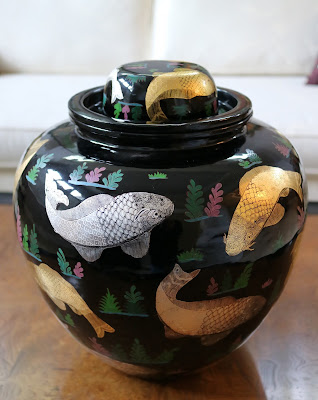 |
| © 2016, R. Ono |
Twice in our travels, we needed to ship a purchase back to the US. First in Rome, when we purchased a 24 inch round ceramic plate and, in Myanmar, for a 16 inch high and 15 inch diameter round water lacquer jar with gold and silver foil inlay. The Rome plate was shipped via a FedEx air shipper and was delivered to our residence. The water jar was a completely different story.
When we purchased the water jar, we were informed that the shipping cost would be $500USD. While this cost represented a substantial expense relative to the jar purchase price, we decided to go ahead. Little did we realize the implication of the shipment not being through a standard international air shipper but, instead, destined for a cargo ship. As we left the lacquer shop, the water jar was hand-packed into a wooden box with tin nailed to the box exterior as an additional protection layer. The 20 inch square tin box was then delivered to the Port of Yangon, where it was placed on a pallet and loaded into a steel cargo container aboard a cargo ship. The cargo ship sailed to the Port of Los Angeles and, from there, to the Port of Oakland.
After two months, I received an email from the shipping company in Los Angeles. Apparently, handling the cargo incurred Los Angeles pier and shipment handling fees of $235USD. Instructions for picking up the tin box could only be released after payment of this fee. This additional fee was never explained to us when we paid the initial $500 shipping fee in Myanmar.
To pick-up the jar, the paperwork stated that I needed to visit US Customs in San Francisco, about a two-hour drive in moderate traffic from my residence. Once at the San Francisco US Customs entry desk, I was asked to process my paperwork at the US Customs office in Oakland, now an additional 30 minute drive. US Customs staff were very helpful and I was shortly on my way with Customs approved documents to the actual San Leandro warehouse, an additional 20 minute drive.
At the warehouse, I was required to pay an additional $100USD for San Leandro warehouse handling, fuel and forklift fees. Moreover, I was informed that I could only pick-up the 20 inch square tin box if I also removed the wooden pallet it arrived on. Given that I didn't drive a truck to the warehouse, taking a full size pallet would really be a challenge. If I left the tin box at the warehouse for a couple of days so that I could return with a truck, I was warned that I might have to pay an additional and unspecified warehouse storage fee. Luckily, with enough whining the warehouse agreed to keep the wooden pallet. I believe it wasn't quite clear where the pallet actually originated. I should note while I didn't receive any pre-delivery information about pallet removal, a warehouse sign clearly stated that customers must remove shipper-prepared pallets.
Lessons Learned
- Think twice before deciding to ship large items back to the US from overseas travel destinations that lack access to international air shippers or items that are so large (or small in our case) that they require containerized shipping.
- Shipping costs may exceed the initial shipping fee that you paid during purchase of the item. If your shipment requires containerized cargo moving by ship, you may be liable for pier and warehouse handling fees not covered by the initial shipping fee. In our case, the additional handling fees were about 67 percent of the original shipping fee.
- Check with the final warehouse destination about the need to remove the wood shipping pallet your item may have arrived on - this could determine what type of vehicle you need to bring to the warehouse. Even a 20 inch square box can be secured to a pallet!
- Finally, if you still choose a containerized cargo shipping method just enjoy your item when it arrives. After a while, you will have forgotten the additional expense. A US Customs staff member mentioned to me that many US citizens find this process too expensive and cumbersome to ever repeat again.
No comments:
Post a Comment